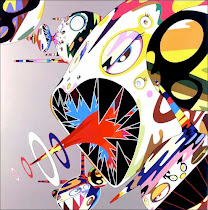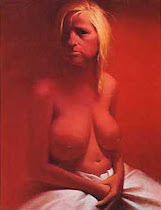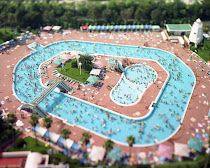Search engine
Tuesday, April 22, 2008
In an attempt of modernisation, to stay in touch with the general mood, the church often commissioned artists to 'communicate'. Sometimes political ideals, sometimes to say "hey!! we went through the middle age to come to meet you!"... But here, I m just being cynical. But contemporary art is more often associated with the idea of Church (the one with a big 'C' which is related to the people, the dogma…etc.) when it comes to architecture. I have seen some stunning things around there and would definitely recommend you to go to see the Liverpool modern cathedral that looks like a nuclear reactor from the outside, or Notre Dame de Ronchamps from Le Corbusier.

Then, are the edgy things, the most simple artworks the one that belongs to a temple? I believe so... and then comes this marvellous artwork commissioned for the St Martin-in-the-Fields Church in London to Shirzeh Houshiary:


 The simple idea of a monochrome stained window that mixes the symbols of the cross and the grid to make a powerful statement about the place of races and gender differences within the Church (the one with a big 'C' literally crystallized by a church feature, the one with a little 'c' this time which only describes the construction).
The simple idea of a monochrome stained window that mixes the symbols of the cross and the grid to make a powerful statement about the place of races and gender differences within the Church (the one with a big 'C' literally crystallized by a church feature, the one with a little 'c' this time which only describes the construction).I think it really makes it. The Guardian goes to qualify this artwork as 'gynaecological reworking of Christian symbols'. Do you understand it better? Sure but there is no need to shock anybody by inserting the word 'gynaecological’ in a description of a stained glass in a church. But there again… it s contemporary art and it is traditionally shocking.
Last questions: Does the nationality of the artist (Iranian) adds value to the overall quality of the artwork? What if I tell you that Shirazeh Houshiary was shortlisted for the Turner Prize in 1994? In the author's death, Barthes criticizes the reader's tendency to consider aspects of the author’s identity—his political views, historical context, religion, ethnicity, psychology, or other biographical or personal attributes—to distill meaning from his work.
It seems a good PR operation to me that eventually leads the commissioning team to declare to the press: "The fact that we are standing now in a church, in front of a window designed by an Iranian woman artist, at the beginning of the 21st century, is truly significant". Sure it is but it seems to me that this cosmopolitan attitude towards contemporary art and especially artists becomes another fashion that will soon be outdated. Will people qualify what we should call 'cosmopolitan art' as the art of the years 2000 as 'extreme art' is now sometimes used to qualify the 90's as the last years of the age of 'controversy as a trend'? Controversy for the sake of controversy>>> cosmopolitan for the sake of postmodernism.
Monday, April 7, 2008
Let's start with the artwork of the month of April that will introduce the next few posts:

Kings Cross, London 2007 by Naoki Honjo
Naoki Honjo is a popular Japanese artist that blurs the border between reality and fiction by using a technique that uses the macro photography visual codes and transposes them to large city views. As some of you may be not particularly familiar with photography techniques, I will show you an example to illustrate this. Do you remember 'crazy art nation' introduced in the post 'another brick in the wall'.
Look closer at how does the picture appear. You will see that the picture gets its maximum of sharpness on the little character that represents Mark Wallinger. The foreground and the background get blurred due to the size of the object and the distance between the scene and the camera lens.

The point here, is that a 'visual culture' exists. Look at the picture above. It is a flower and it is not really hard to guess... But think about it... How do you know it is a flower? There are a few clues: the colors, the water drops, the organic aspect of the subject. The depth of field is one important clue. You have seen many of this flowers close-up and the small depth of field is one of the elements you expect when we show you such pictures. It is part of your visual culture!
When Naoki Honjo shows you a picture of buildings, roads and buses; with such a small depth of field, your brain may conclude that the objects shot on the picture are incredibly small... Probably a model... But no! Not this time, this is 'real', a picture of the actual London.
We might therefore say that Naoki Honjo cheats with our system of perception.
From another angle, we could imagine that a god-like photographer took the picture, starring at us the way we would stare at an ants colony... The presence of something superior, gigantic that looks at us from above and could crush everything we take for unbreakable, with a single finger.
Furthermore, the scenes look like big toys, dolls house, lego (?!) something that questions the social movements, the way we evolve in the city, representational modes.

Saitama-Arena, Saitama, Japan, 2004 by Naoki Honjo

Containers, Tokyo, Japan 2005 by Naoki Honjo

London Buses, 2007 by Naoki Honjo
This is a crystal clear demonstration that the gaze at the artwork is biased on a quite powerful manner by the stereotype we hold about the picture features (here the point of view and the particular depth of field). What I would like to point at, is that we hold stereotypes about everything, it is simply the way the brain works! We may be largely unaware of the stereotypes we hold... The more obvious are the ethnic ones, African are like this, French like that... But Naoki Honjo brilliantly demonstrates us, using quite a poetic channel that it may not be that simple!







